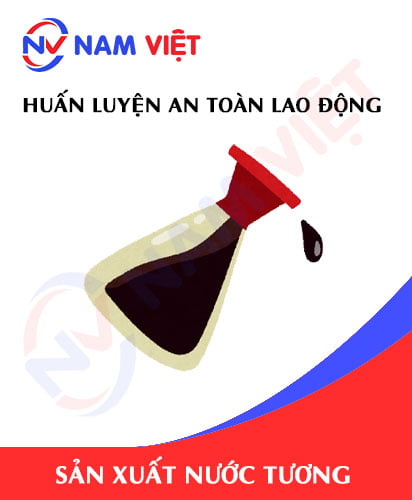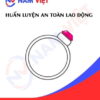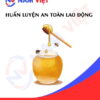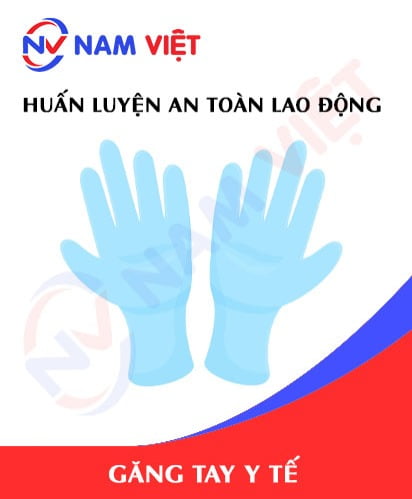Occupational safety training for soy sauce manufacturing
99,000 ₫
Note: The above price is calculated per person, the price may vary depending on the number of trainees participating in the course and market fluctuations. For more accurate pricing support, please refer to the quotation or contact our consultants directly.
Occupational safety is an important issue in soy sauce manufacturing factories and needs to be addressed promptly to ensure the health and safety of workers, and enhance the reputation of businesses. The Occupational Safety Training course is one of the effective solutions to raise awareness about how to prevent workplace accidents for workers participating in soy sauce manufacturing.
Table of Contents
Toggle1. Overview of Soy Sauce
a. What is Soy Sauce?
- Soy sauce is a condiment widely used in the traditional cuisine of many Asian countries, including Vietnam. Soy sauce is made from soybeans and salt, and can be aged in wooden barrels to create its distinctive flavor. Soy sauce has many different uses in cooking, from dipping sauces, making sauces for dishes, to using in dipping sauces, soups, and braised dishes.
- Similar condiment products to soy sauce include: oyster sauce, soy sauce…
- The soy sauce manufacturing industry in Vietnam is one of the strongly developing food industries, meeting the needs of both domestic and foreign markets. According to statistics from the Ministry of Industry and Trade, the domestic soy sauce manufacturing output reaches about 270-300 thousand tons/year and exports about 50-60 thousand tons/year. Soy sauce is manufactured in provinces and cities nationwide; however, the key localities for soy sauce manufacturing in Vietnam are Hanoi, Hai Duong, Thai Nguyen, Hung Yen, Hai Phong, Nam Dinh, Bac Ninh, Thua Thien Hue, and Ho Chi Minh City.
- Soy sauce manufacturing businesses in Vietnam vary in size, from small, family-owned manufacturing facilities to large corporations. Many soy sauce manufacturing businesses have applied modern technology to increase productivity, improve product quality, and meet the market’s growing demand. Famous brands in the Vietnamese soy sauce industry include: Chinsu, Tam Thai Tu, Vissan, Nam Ngu, Hao Hao, Cai Lan, Meizan, Kim Lan, Nong Thanh, Vinh Thanh, and many other brands.

b. Types of machinery for soy sauce manufacturing
There are many types of machinery used in soy sauce manufacturing at factories, including:
- Soybean washing machine: This machine is used to wash and clean soybeans before they are cooked for soy sauce.
- Soybean grinder: This machine is used to grind and crush soybeans, creating a clean soybean mixture.
- Soy sauce cooking machine: This machine is used to cook the clean, crushed soybean mixture with water to create soy sauce.
- Soy sauce pressing machine: This machine is used to press the cooked soybean mixture to separate the soy sauce and the soybean pulp.
- Distillation machine: This machine is used to distill the soy sauce and separate the flavors and colors.
- Bottling machine: This machine is used to package soy sauce into bottles or containers for storage and consumption.
In addition, there are other machines such as mixers, pumps, containers, etc., used to help the soy sauce manufacturing process run efficiently and achieve the desired quality.

c. Typical soy sauce manufacturing businesses
Some typical soy sauce manufacturing businesses in Vietnam include:
- Cholimex Food Joint Stock Company: A leading company in Vietnam in the production and trading of food products, including soy sauce.
- Nam Ngu Soy Sauce Co., Ltd.: A company specializing in producing concentrated soy sauce and liquid soy sauce with famous brands like Nam Ngu
- Viet Han Food Co., Ltd.: A business specializing in producing food products, including soy sauce, under the Bao Long brand.
- Dai Viet Trading & Manufacturing Co., Ltd.: A company producing and supplying food products, including soy sauce, under the Nam Vang brand.
- Bich Chi Food Joint Stock Company: A business producing soy sauce and other food products, with the Bich Chi brand.
d. Specific jobs in a soy sauce factory
Group 1
- Executive director, deputy executive director, department head in a soy sauce factory.
Group 2
- Safety officer: manages safety in the factory, designs safety procedures, supervises and urges employees to comply with safe work procedures.
Group 3
- Material preparation: This is the first step in soy sauce manufacturing. The necessary ingredients include soybeans, salt, sugar, water, and additives like flavorings, preservatives, and thickeners.
- Soybean grinding: Soybeans are ground to form a uniform mixture.
- Dissolving sugar and salt: Sugar and salt are dissolved in water and stirred well.
- Cooking the soybean mixture: The soybean mixture is boiled and stirred for a certain period to remove impurities and help form a uniform mixture.
- Cleaning the mixture: The mixture is poured into a filter to remove any remaining impurities.
- Soy sauce processing: Additives are added to the soy sauce mixture to create its characteristic flavor.
- Bottling: The soy sauce is bottled and packaged for distribution to customers.
- Quality control: Before packaging, the soy sauce is quality-checked to ensure the product meets standards and is safe for consumers.
- Factory sanitation: Equipment, machinery, and manufacturing areas must be cleaned thoroughly to ensure food safety and hygiene.
- Product preservation: After manufacturing is complete, the soy sauce product needs to be stored at an appropriate temperature and checked regularly to ensure its quality and safety.
Group 4
- Office work, service, sales, marketing.
- Manufacturing management, quality management, human resource management, material management, financial and accounting management.
- Research and development of new products, designing product packaging.

2. Overview of the occupational safety training course for soy sauce manufacturing
Within the scope of this article, we will focus on issues related to group 3, because group 3 is the group directly involved in the manufacturing process, and bears the highest risk of occupational safety. Learn more about other groups here
a. What is group 3 occupational safety training?
- Occupational safety training for group 3 consists of sessions that equip workers with awareness of how to prevent occupational accidents.
- The occupational safety training course will help workers identify and avoid dangers, and minimize the risks of occupational accidents during work.
REGISTER FOR OCCUPATIONAL SAFETY TRAINING SERVICES
b. Training duration
Initial safety training duration
- The total training duration is at least 24 hours, including the examination time.
- 8 hours of theoretical study on policies and laws regarding occupational safety and hygiene.
- 8 hours of theoretical study on basic knowledge of occupational safety and hygiene.
- 4 hours of theoretical study on specialized training content.
- 2 hours of practical training on specialized training content.
- 2 hours for the final theoretical test of the training course.
The safety training center will divide the time into several training sessions depending on the time arrangement for employees. But generally, there are 6 training sessions, and the course will last 3 days, provided that the manufacturing company can arrange continuous study time.
Periodic safety training duration
- Before the safety card expires, if the worker wants it re-issued, they must undergo a periodic occupational safety training course, with the periodic safety training duration being at least 50% of the initial safety training duration.
Explanation: The total duration of periodic occupational safety training is at least 12 hours, including the examination time. After completing the periodic training course and passing the test, the worker will be re-issued or have their safety card renewed.
c. Content of the training course
| No. | TRAINING CONTENT | TRAINING DURATION (HOURS) | |||
| Total | Of which | ||||
| Theory | Practice | Test | |||
| I | Policies and laws on occupational safety and hygiene | 8 | 8 | 0 | 0 |
| 1 | Overview of the legal documents system on occupational safety and hygiene. | 6 | 6 | ||
| 2 | System of standards and technical regulations on occupational safety and hygiene. | 1 | 1 | ||
| 3 | Specific regulations of state management agencies on occupational safety and hygiene when newly building, expanding, or renovating facilities, and for the production, use, storage, and inspection of machinery, equipment, materials, and substances with strict safety and hygiene requirements. | 1 | 1 | ||
| II | Basic knowledge of occupational safety and hygiene | 8 | 8 | 0 | 0 |
| 1 | Basic knowledge of dangerous and harmful factors at the workplace. | 4 | 4 | ||
| 2 | Methods to improve working conditions. | 1 | 1 | ||
| 3 | Safety culture in production and business. | 1 | 1 | ||
| 4 | Rights and obligations of employers and employees; policies and regimes on occupational safety and hygiene for employees; functions and duties of the occupational safety and health network. | 1 | 1 | ||
| 5 | Occupational safety and hygiene regulations, signs, safety and hygiene guides and the use of safety equipment, personal protective equipment; skills in first aid for occupational accidents, and prevention of occupational diseases. | 1 | 1 | ||
| III | Specialized training content | 6 | 4 | 2 | 0 |
| General knowledge about machinery, equipment, and substances that generate dangerous and harmful factors; analysis, assessment, and management of occupational safety and hygiene risks, safe working procedures with machinery, equipment, and substances with strict occupational safety and hygiene requirements. | 6 | 4 | 2 | ||
| IV | Occupational safety training test at the end of the course | 2 | 2 | 0 | 0 |
| Total | 24 | 22 | 2 | ||
See more training content for 6 groups
d. Occupational safety card
After completing the occupational safety training course and passing the test, the worker will be issued an occupational safety card (also commonly called a group 3 occupational safety certificate).
The group 3 safety card will clearly show information such as: full name, date of birth, specific job and working environment. It also includes the training duration, a red seal, and a signature confirming the completion of the training course.
According to the regulations for issuing safety cards as specified in Clause 2 of Article 24 of Decree 44/2016/ND-CP, there are two cases:
- In the case where the employer and the employee have a labor contract with each other, the employer must sign, seal, and place an overlapping seal on the safety card for the group 3 trainee after they have completed the training course from the occupational safety training provider and passed the test.
- In the case of a freelance or seasonal worker who does not have a labor contract, the training provider must sign, seal, and place an overlapping seal on the safety card for the worker after they have completed the training course from the occupational safety training provider and passed the test.

3. Recognizing dangers in soy sauce manufacturing
Some of the dangers that can occur during soy sauce manufacturing include:
- During manufacturing, the use of chemicals for preservation or coloring can pose a danger if not used correctly. In addition, the storage, transportation, and handling of chemical substances can also be dangerous if not done properly.
- The use of electrical equipment and lighting can cause electrical hazards if not maintained and used correctly. High voltage and current can also pose a danger to users if proper protection measures are not in place.
- The soy sauce manufacturing process often involves the use of equipment and machinery that can generate high temperatures. If safety is not ensured during use, it can pose a danger to workers.
- The soy sauce manufacturing process must ensure cleanliness and hygiene to ensure product quality. If hygiene procedures are not followed correctly, the final product can be contaminated or its quality compromised.
- The equipment and machinery used in the soy sauce manufacturing process can pose a danger if not maintained and used correctly. Ensuring the safety of equipment and machinery will minimize the risk of occupational accidents.
4. Common occupational accidents in soy sauce manufacturing
Types of common occupational accidents that occur during soy sauce manufacturing can include:
- Fire and explosion accidents: Because chemical products used to manufacture soy sauce can cause fires and explosions if not used correctly or stored unsafely.
- Chemical accidents: The types of chemicals used to manufacture soy sauce can be harmful to workers’ health if not used correctly.
- Electrical accidents: Due to the use of electrical equipment in the soy sauce manufacturing process, electrical incidents such as electric shock or short circuits can occur.
- Laceration accidents: Workers can be injured by using sharp tools during manufacturing, such as knives, scissors, and other cutting tools.
- Physical impact accidents: During the operation of soy sauce manufacturing machinery, workers may encounter occupational accidents such as collisions, falls, etc.

5. Safety measures when participating in soy sauce manufacturing
Safety measures when participating in soy sauce manufacturing include:
- Employees in the soy sauce factory need to be trained on safe manufacturing procedures, use correct personal protective equipment and accident prevention measures.
- The soy sauce factory needs to ensure food safety and hygiene during manufacturing, packaging, and transportation.
- Employees in the factory need to fully use personal protective equipment such as safety glasses, masks, gloves, and non-slip shoes.
- Soy sauce manufacturing equipment needs to be checked periodically to ensure it works well and does not cause accidents.
- When transporting soy sauce from the factory to sales points, it is necessary to ensure safety and avoid damaging the product. Careful product packaging and the use of safe transportation means are essential.
- The soy sauce factory needs to organize periodic checks of pipelines and machinery systems to ensure they are working well and do not pose risks during the manufacturing process.
- Use safe and high-quality ingredients to ensure the soy sauce product is manufactured safely and does not harm consumers.
- Periodically organize work environment monitoring in factories and businesses, collect and analyze harmful factors for workers, and then adjust to reduce the level of harm to prevent occupational diseases for them.
6. Benefits of occupational safety training for soy sauce manufacturing
An Toan Nam Viet provides businesses with the following excellent benefits after completing occupational safety training courses as stipulated in Decree 44/2016/ND – CP regarding occupational safety and hygiene for companies, factories, businesses.
- Workers can identify potential risks of occupational accidents and take preventive measures to avoid accidents.
- Businesses can establish risk prevention measures in manufacturing, operation, and maintenance processes.
- Minimize costs when safety risks occur in the workplace.
- The manufacturing process is not interrupted, which helps increase labor productivity and product quality.
- Comply with occupational safety laws, avoiding legal risks.
- Create prestige and professionalism in all aspects, thereby elevating the brand of your business.
- An Toan Nam Viet’s training courses are a solution to prevent and combat external factors affecting each individual so they can avoid danger that can lead to injury or, more seriously, death.
REGISTER FOR OCCUPATIONAL SAFETY TRAINING SERVICES
7. Customer feedback after completing the occupational safety training course for soy sauce manufacturing
An Toan Nam Viet has many years of experience in the mission of accompanying many businesses in Vietnam in general and in the southern provinces in particular. And that responsibility is something extremely valuable to An Toan Nam Viet, which is why An Toan Nam Viet’s Occupational Safety Training work is always focused on becoming more professional. The motivation for An Toan Nam Viet to grow strongly to the present day comes from the positive feedback and suggestions from businesses. Below is the feedback from our partners whom we have served.
Bac Nam E&C Construction Investment Joint Stock Company
“The first time I used the service at An Toan Nam Viet, I was very surprised by the enthusiastic 24/7 support of the team of consultants. The class organization was very quick and convenient for our company; thank you very much for An Toan Nam Viet’s service!”
Hoa Dat Construction and Trading Joint Stock Company
“An Toan Nam Viet’s service has helped us a lot in simplifying occupational safety and completing safety files for our work process. The team of consultants is enthusiastic and timely in answering our questions. 5 stars for An Toan Nam Viet”
See more customer interviews after using An Toan Nam Viet’s services
8. An Toan Nam Viet’s Occupational Safety Training Capability
An Toan Nam Viet is a reputable and high-quality occupational safety training center in Vietnam today. With occupational safety training sessions continuously held at production workshops, factories or construction sites across the country (63 provinces and cities in Vietnam).
REGISTER FOR OCCUPATIONAL SAFETY TRAINING SERVICES
License for occupational safety training
- An Toan Nam Viet has been inspected and granted a certificate of eligibility to operate occupational safety and hygiene training by the Department of Labor Safety of the Ministry of Labor – Invalids and Social Affairs . This further strengthens our capability to provide occupational safety training.

Documents and lectures
- Before occupational safety training documents are included in occupational safety training courses, they are reviewed and approved to ensure that the lectures are factually correct and effective when applied.
- The teaching method of our lecturers is synchronized according to the teaching standard of An Toan Nam Viet, which is a method that experts in occupational safety and hygiene training have researched and distilled during the teaching process to bring the highest level of knowledge absorption to students.
Facilities
- Controlling the factors in the classroom that affect the training process will increase teaching efficiency and the effectiveness of knowledge absorption for students.
- Our facilities supporting the training course always have spacious classrooms that meet standards for area, lighting, training equipment … etc…
9. Reputable and high-quality national safety training center
At An Toan Nam Viet, we always prioritize our professional dedication to occupational safety training. For us, imparting knowledge of self-protection to workers so they are safely equipped on their livelihoods is a contribution to building the country.
To ensure effective training, we prepare carefully and meticulously for every little detail, no matter how small. From preparing tools, equipment, teaching aids to curricula, documents, sound, and lighting.
Our occupational safety trainers are experts with many years of experience in the field. They even have research on identifying dangers in all occupations and how to prevent them.
The trainers’ lectures are distilled from practical experience and conveyed in the most vivid and easy-to-visualize way for workers. These factors help workers feel comfortable during their study time and absorb our teaching knowledge well. Of course, the knowledge conveyed always closely follows Decree 44/2016/ND-CP.
From there, they grasp many measures to prevent dangers and how to protect themselves. At the same time, they can apply it in the most appropriate way in their actual work.
Our safety training center is proud to be a reputable and professional provider of occupational safety training services with the following advantages:
- Competitive training costs but training quality is still guaranteed.
- Flexible training schedule adapted to the company’s manufacturing situation.
- Quick occupational safety training certification procedures, in accordance with the law.
- Trainers are people with many years of experience in the profession.
- The classroom is controlled for factors affecting the training process, increasing teaching efficiency and the effectiveness of knowledge absorption for students.
- The lectures are compiled to be suitable for occupational safety work at businesses.
- An Toan Nam Viet works with dedication and professionalism to support customers accurately and quickly.

10. Reference more occupational safety training documents for soy sauce manufacturing
- Occupational safety documents for soy sauce manufacturing
- Occupational safety training document set
- Occupational safety training test question set
- Multiple-choice test for occupational safety in soy sauce manufacturing
- Lecture slides for occupational safety training in soy sauce manufacturing
1 review for Occupational safety training for soy sauce manufacturing
No comments yet















namchinh.haiphong341
Dịch vụ tốt!!!